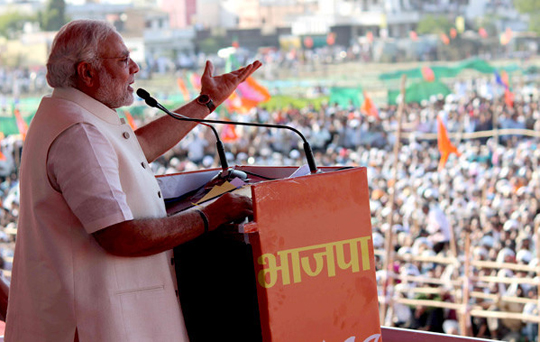On May 26, 2017, the Modi Government completed three years in office. Various programmes such as the Modi fest were organised at various places and there are plans to celebrate them in different cities across the country. The underlying message of these programmes is that Modi government has done remarkable work and the country is moving towards prosperity for all. Modi has been labelled as ‘Garibon ka Masiha’ (Prophet for poor) by his acolytes. Many channels and commentators gave him excellent grade citing various achievements.

As such, what has happened during last three years? Precisely, there has been centralisation of power in the hands of the Prime Minister. It seems the cabinet system has been given a go by.
Modi mirage and the politics of disillusion
To begin with, one does concede that this regime scores extremely high in image creation. It has been able to sell damaging moves like demonetisation as something good for the country. While a majority of the people are living under the illusion propagated by the government and its promotion by the subservient media, the situation on ground is degrading in the cases of production, prices of daily commodities, number of jobs created and the average standard of living.
The healthcare system has taken a further beating. Farmer suicides have gone up. Protest against anti-farmer policies by peasants from Tamil Nadu has been underplayed like most of the protests in the country.
Shift from black money to the Holy Cow
The fate of electoral promises is well reflected in non-fulfillment of the promise of deposition of 15 lakh INR in accounts of all and in absolute failure of job creation. After using Ram Temple issue for polarisation, now the Holy Cow has been brought into the arena of politics. This cow worship has led to the violent lynching of Muslims and Dalits. The cow-protection policies of the government have emboldened vigilantism and killings in the name of ‘gauraksha’. While those guilty of crime are let off, the victims have been penalised on several grounds.
Failures in the garb of achievement
The social scene is dominated by illusory promises and issues related to identity. One recalls that in the UPA regime, the propaganda was much less and the major issues to be debated were related to the rights of the people to have food, education, healthcare and employment.
Currently, a false bravado permeates the air. One surgical strike is touted to be the achievement of the Government, while regular skirmishes are going on at the border with serious casualties to the army men. The Kashmir policy has created a situation where not only the disgruntled boys but even girl students have taken to the streets, pelting stones. The anguish of Kashmiris remains unattended, while the failure to establish dialogue with Pakistan is aggravating the situation.
Redefining patriotism: The rise of Hindutva
In matters of political orientation, Hindutva is the overarching concern. Most glaring intrusions of ideological nature are in the field of education. The autonomy of Universities has been gradually taken away and the culture of erosion is dominating the field of academia. The new slogan is to revive the ‘traditional faith’ as ‘knowledge’ and to treat the mythology as history and to accord the status of science to the age-old empirical knowledge. Here, the traditional knowledge is cherry-picked which is elite or Brahmanical one, like the promotion of the Gita, Sanskrit and everything that is Hindu.
From among all sections of people who contribute to the well-being of society, the military has been given the exalted status of saviour of the country, while the food producers and other sections providing service to the nation have been marginalised. In the times of Lal Bahadur Shastri, the slogan was ‘Jai Jawan, Jai Kisan’ (Hail the army man, hail the farmer). Now, the farmer has been dropped.
The dawn of realisation
The overall democratic space has been stifled, with a large section of the media bowing to the ruling government and taking to task the Opposition. The media has given up its role of being the watchdog of the Government and the proverbial fourth pillar of any democracy. This trend of intolerance which began with murders of Narendra Dabholkar, who was a crusader against superstition, Govind Pansare and M. M. Kalburgi, has reached its zenith.
Favourable public opinion, in spite of all these failures on the part of the government, signifies how a propaganda can create an illusion of well-being. Nonetheless, the dissatisfaction of the people is rising. During the last three years, one has witnessed major uprisings against policies of the Modi Government.
While the mobilisation of farmers has forced the government to withdraw the Land Reforms Bill, the agitation by Kanhaiya Kumar, the protests in Ramjas College, Hyderabad University and the resentment in Una tell us that the goodwill of the Modi government is in retrograde motion. While Hindutva forces are becoming more assertive, these campaigns and movements raise our hope for a plural and liberal society based on values of the Indian Constitution.





Comments
Add new comment